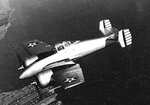oldcrowcv63
Tech Sergeant
Rear Admiral E.J. King, wakes up on June 12, 1936 on his last day as Chief of BuAer and discovers to his chargrin that he has been the subject of Admiralty Mind Control Experiments similar to those performed on Englishman by the sentient blamonges from Planet Skyron in the Andromeda galaxy in order to win wimbledon fortnight. King's thinking is now governed by RN/FAA philosophy. He calls his aide and orders him to generate a request sent to american aircraft companies and the the NAF Warminster facility to submit proposals for a two-seat multirole carrier fighter.
What would be the result assuming his immediate institutionalization (ordered by the USN heirarchy) does not abort the effort. (This scenario is historically accurate and is the source of King's well know anglo-phobia)
Just curious what you wags think such an aircraft might resemble and how it might compare to the Fairey Fulmar.
Tomo, this is one for you!
My own vision is that of a Brewster Buccaneer-like fighter bomber (~ SBA-1) the mere sight of which would clear the skies of all opposition due to uncontrollable spasms of hilarity. But I wonder what Grumman would have done starting with its prior experience with the 2 seat FF-1 fighter.
What would be the result assuming his immediate institutionalization (ordered by the USN heirarchy) does not abort the effort. (This scenario is historically accurate and is the source of King's well know anglo-phobia)
Just curious what you wags think such an aircraft might resemble and how it might compare to the Fairey Fulmar.
Tomo, this is one for you!
My own vision is that of a Brewster Buccaneer-like fighter bomber (~ SBA-1) the mere sight of which would clear the skies of all opposition due to uncontrollable spasms of hilarity. But I wonder what Grumman would have done starting with its prior experience with the 2 seat FF-1 fighter.
Attachments
Last edited:


